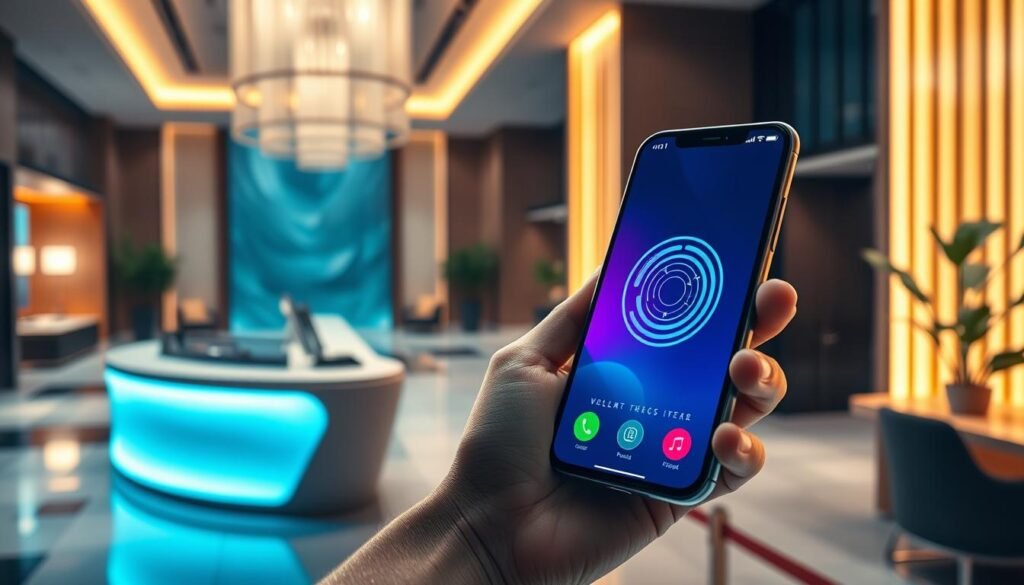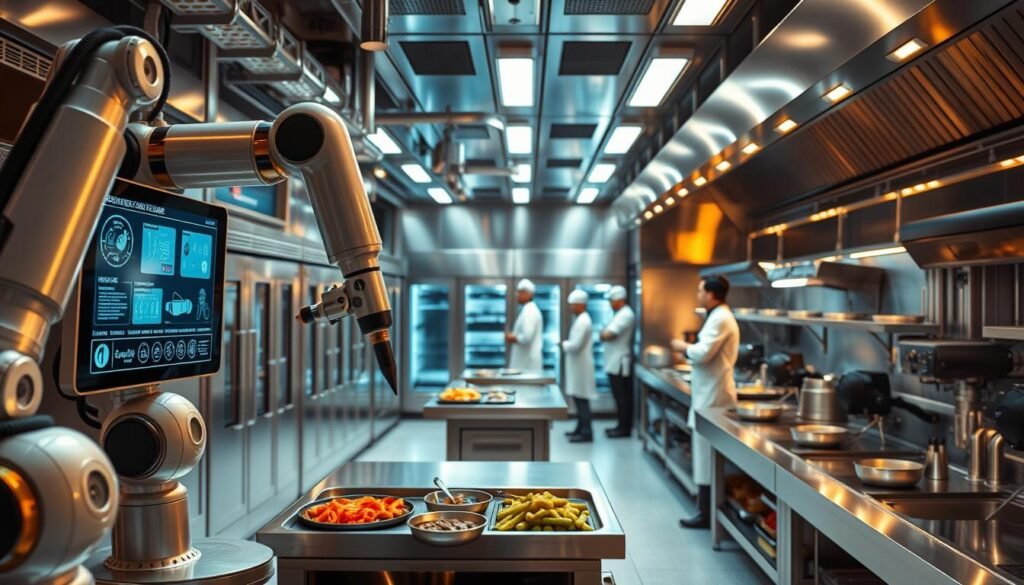HOME / SINGLE POST

Surprising fact: a recent survey found that over 70% of travellers say seamless digital service can change their choice of hotel.
We open the year with a clear message — innovation is reshaping the guest journey from booking to check‑out. Cloud platforms, AI personalisation and smart-room devices already let brands offer faster check‑in, connected-room controls and app-based keys.
We’ll show how early adopters such as Hilton and Marriott use APIs and robotics to ease staff pressure and lift guest satisfaction. Our aim is practical: concrete examples, simple steps and measurable pay‑offs for UK businesses facing tight staffing and rising costs.
Read on and you will find clear, scannable sections that help you match solutions to your operation — from pricing powered by AI to IoT rooms, contactless payments, VR marketing and stronger data security for the hospitality industry.
We see quick change across the UK as guests expect quicker, digital-first service. This shift touches hotels, restaurants and smaller hospitality businesses, and it alters how teams plan daily work.
Contactless adoption has surged: 70% of millennials now favour contactless operations and 79% of diners expect tech options when ordering. That means faster check‑ins, mobile orders and fewer queues — a simpler experience for guests.
With tight staff numbers, operators turn to automation to ease repetitive tasks. Mobile check‑in, digital keys and self‑serve kiosks reduce bottlenecks and free teams to focus on memorable service.
| Operation | Quick win | Expected gain | Priority |
|---|---|---|---|
| Front desk | Mobile pre‑arrival | Faster arrivals, fewer queues | High |
| Food & beverage | Mobile ordering | Reduced wait, accurate allergen data | High |
| Guest support | Chat & messaging | 24/7 help, lower labour load | Medium |
Practical tip: start with mobile pre‑arrival and guest messaging, ask for rapid feedback, then scale. That keeps the human touch while raising efficiency and guest experience as these trends gather pace.
Hotels now stitch together data and devices so guests feel a smoother, more personal stay. Below we map the main shifts that will shape service, revenue and sustainability this year.
Predictive analytics drives demand forecasting, dynamic pricing and personalised offers. UI‑less operations automate bulk check‑ins and routine rules, freeing staff to focus on experience.
Mobile keys, occupancy sensors and app controls let rooms adjust lighting, heating and privacy. Examples from major brands show how rooms become an extension of the guest app.
From bookings to digital check‑out, mobile journeys reduce friction and cut plastic cards. Branded apps combine loyalty, payments and room controls for one seamless flow.
Robots aid deliveries and cleaning, while VR and AR lift marketing and wayfinding. Strong cybersecurity—segmented guest networks and secure remote access—keeps trust intact.
Modern AI tools join your team — answering FAQs, flagging guest issues and suggesting the best offers.
Always-on chat handles routine requests, manages bookings and escalates complex matters to staff. Brands such as Hilton with “Connie” and Marriott’s multilingual assistants show how round‑the‑clock help lifts satisfaction at busy city and airport sites.
Predictive models learn from guest behaviour and booking history to set smarter pricing and forecast demand. That drives timely offers and helps the team capture more revenue without added effort.
Emotion AI spots frustration or delight so managers can intervene early. Paired with CRM and PMS, these tools craft subtle upgrades and relevant messages that improve the guest experience.

Mobile wallets and app-led journeys are quietly reshaping how guests pay and move through a hotel stay.
We see branded apps carry the whole journey — booking, pre-arrival, room selection and mobile keys. Guests use the same app to control the room, request service and complete payment without queueing at the desk.
One app, one wallet: apps place digital receipts, loyalty benefits and room controls in a single view. That boosts convenience and raises guest satisfaction during busy check-ins.
Apple Pay, Google Pay and stored cards reduce card declines and speed checkout. Biometric authorisation adds security and makes quick settlement feel natural to users.
“Make opt-in simple and keep human help visible for anyone who wants it.”
We recommend measuring app adoption, mobile key usage, average check-in time and payment success rate. These metrics show whether the innovation is easing work for staff and improving the guest experience across UK properties.
Smart systems now let hotels act fast on data, turning routine tasks into simple background work. A cloud‑native PMS becomes the core — centralising reservations, billing, housekeeping and profiles with reliable remote access.
Cloud delivery means automatic updates, backups and failover. APIs link the PMS to CRM, POS, gateways and booking engines so bookings and payments sync without manual entry.
IoT sensors let HVAC and lighting respond to occupancy. That saves costs and keeps the room comfortable for guests. Quick gains in energy efficiency can fund better guest-facing upgrades.

Modern kitchens use screens and sensors to turn frantic services into predictable rhythms. We see digital displays, synced inventory and simple recipe tools change how teams work during the rush.
Kitchen display systems (KDS) streamline prep and ticket timing. Recipes, allergens and prep stages appear on screen so staff hit promised wait times.
Automated inventory syncs with sales. That cuts ordering errors and keeps popular dishes in stock, so margins improve for UK hotels and restaurants.
Centralised management keeps allergen and nutritional data current across menus and PPDS. This reduces risk and makes audits straightforward.
Data‑led forecasts and prep plans cut over‑ordering and spoilage. Operators save on paper by digitising schedules and checklists.
| Feature | Benefit | Metric to track |
|---|---|---|
| KDS & recipe tools | Faster, accurate prep | Prep accuracy (%) |
| Inventory sync | Better ordering, higher margins | Stock outs per week |
| Allergen module | Consistent compliance | Allergen incidents |
| Waste forecasts | Lower food waste | Waste per cover (kg) |
Practical note: choose systems that integrate with front‑of‑house so promises match capacity. The best solutions are simple to use mid‑rush and rock‑solid during peak service.
When staff feel supported, guests notice the difference in every stay. We focus on simple changes that free teams, lift guest satisfaction and make loyalty feel personal.
Automated rota tools create shifts, allow swap requests and give mobile access to schedules. That flexibility helps staff balance life and work and improves retention.
Quick onboarding modules cut training time. Staff use the same app for shifts, training and task lists so service stays consistent during busy periods.
Platforms pull EPOS, PMS and booking data to build profiles. That lets us deliver relevant offers—late check‑out, upgrades or dining credits—that feel earned, not generic.
| Feature | Benefit | Metric |
|---|---|---|
| Automated rota | Better coverage, happier staff | Labour variance (%) |
| CRM-linked loyalty | Higher return visits | Repeat rate (%) |
| Messaging & promos | Faster bookings, clear comms | Conversion rate (%) |
Practical note: small businesses can start with basic tiers and grow as data matures. Training and simple playbooks keep tools human-centred and effective.
Rolling out new systems starts with small, reversible steps that protect service while you adapt. We recommend a staged plan that keeps guest services steady, limits disruption and builds confidence across the team.
Choose solutions that offer open APIs so new software links cleanly to your PMS and POS. Start by integrating payments and reservations, then add CRM, messaging and loyalty.
Cloud migration brings scalability, remote access and automatic updates. It reduces dependence on on‑premise hardware and shortens maintenance windows.
Balance licensing, setup and running costs against gains in efficiency, upsell revenue and direct bookings. Use a pilot to model expected increases in revenue and lower labour spend.
Key metrics: average check‑in time, cost per acquisition, direct revenue, labour cost % and satisfaction scores.
Deliver role‑based modules and short refreshers so tools become second nature. Add on‑shift support and quick reference guides to keep human warmth visible while tech runs the background tasks.
Delay raises the risk of poor customer experience and revenue leakage when processes remain manual. Pilot in one hotel or department, measure results, then scale with lessons learned.
“Pilot first, measure carefully, then scale — that way you protect guests and prove the ROI.”
| Focus | Immediate gain | Metric |
|---|---|---|
| Integration (PMS & payments) | Faster check‑ins | Average check‑in time |
| Training & on‑shift support | Consistent service | Satisfaction scores |
| Pricing optimisation (AI/RMS) | Higher revenue per room | Direct revenue |
Aligning people, platforms and data is the quickest way to lift guest satisfaction.
We see clear benefits when a cloud PMS, mobile apps and secure payments work together. That mix speeds check‑ins, boosts direct bookings and frees staff to focus on service.
Smart room controls and occupancy‑based HVAC cut energy and support measurable sustainability wins. AI pricing and demand forecasting help protect value while growing revenue.
Keep systems open with APIs, train teams on the new tools and pilot one friction point first. Small pilots show gains in efficiency, guest experience and loyalty — and make wider rollouts easier.
Take one step today: pilot a single solution, measure the lift, then scale with confidence.
Never miss any important news. Subscribe to our newsletter.